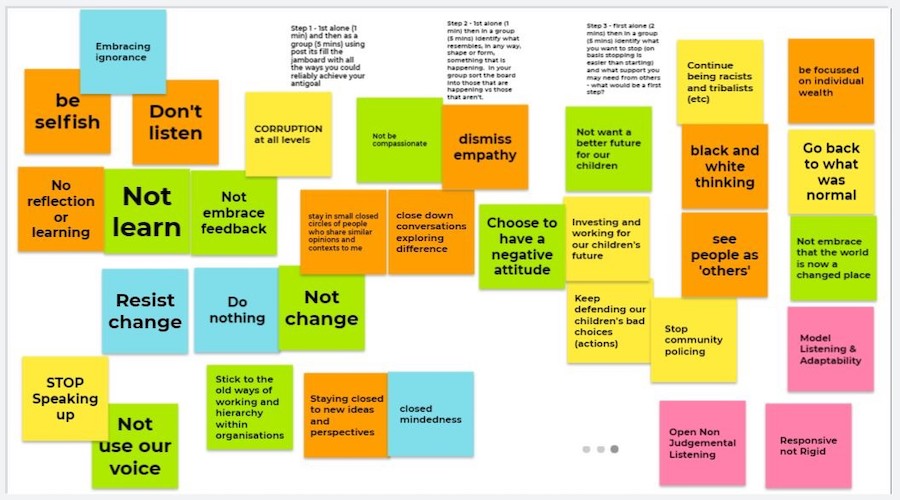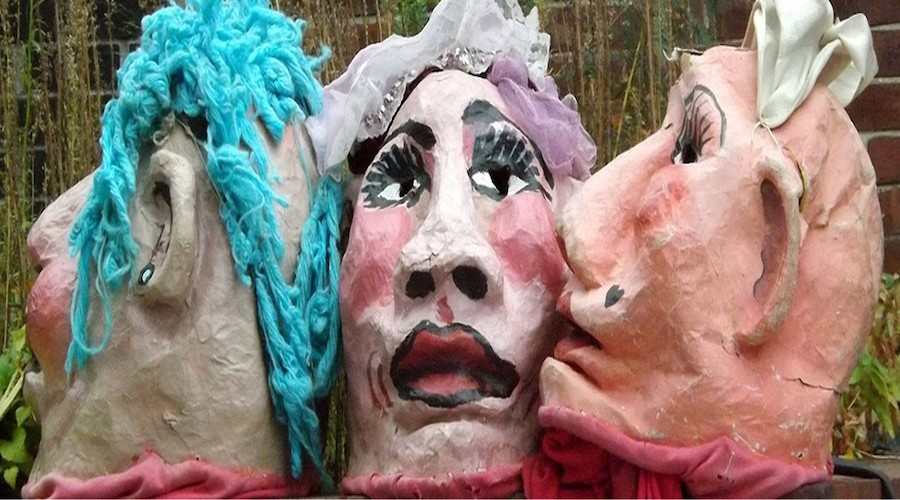Let’s Give Everybody an Equal Voice
On a Friday in August 2020, we held our third online Liberating Structures Immersion Workshop. Once again, it was rated among the most engaging conferences we’ve ever held.
Imagine at your events if everybody got to speak equally. Imagine the most senior people did not get to dominate the discussion. Imagine the loudest voices weren’t the ones who carried the decisions.
In this blog, Henry Stewart goes through nine Liberating Structures, which make it so everybody has an equal voice.
Get in touch

Mad Tea (Breakouts)
Six successive breakouts of two people, 2 mins each. Six separate prompts.
In real life, this is done in a circle, with people facing each other. A prompt is displayed (eg, “The key purpose of my work currently is…”), people answer it. After 1 or 2 minutes they move round to face the next person and answer the next question.
Online its simply done in breakouts of two. Pose the questions in the chat before and put people into their two person breakouts. Bring them back after two minutes, pose a new question and recreate breakouts.
It is a great way to meet people at the start of an event, creates energy and, if you relate the questions to what is to be discussed, it gets the thinking going straight away.
“Energising”
“made us feel equal”
“Loved it. Never done it before. Would love to use in all meetings!”
124All
Pose an issue: 1 minute reflection on own; 2 mins in pairs; 4 mins in fours; then discuss together
This is probably the most popular Liberating Structure in real life, so easy to use to get people involved in whatever the issue is. Online it works exactly the same except, with large numbers, the fours are randomised, rather than two pairs coming together. (With small numbers you can still achieve that by moving the pairs from one breakout room to a room with another pair.)
Taking a minute to think is so rare at the meetings we attend (unless you are a quaker) but, especially if you like to reflect, it can be crucial to get people’s best ideas.
This is really worthwhile to do for any new topic, as everybody gets to think about it and express their views.
“Gave everyone a voice”
“Gathering lots of ideas, bringing quieter people into the conversation”
“Great to have time for individual reflection and gather thoughts first before talking to others”
TRIZ
Take what you want to achieve and think of the worst that can happen (eg, “what would lead to this project being a complete failure?”), set down all the things that would lead to that bad outcome (5 mins). Then reflect on which of these you are actually doing (1 min alone, 5 minutes together). Finally decide the things that you will stop doing (2 mins alone, 5 mins together).
TRIZ can be great fun as you explore the worst possible things that can happen. But, in looking at your situation from a different viewpoint, it also prompts challenge. Examples might be “not listening”, “having the most senor people dominating meetings”, “not embracing feedback”.
Use it at the beginning of a project, or with participants on a long-term learning programme to explore what could lead to it not working and how to ensure that doesn’t happen.
My colleagues Mikala and Lyse use Jamboard for this, Google’s post it tool. It’s a great way to interact, being able to set ideas on post-its and move them around. An example here.
“Really engaging, all had a voice, encouraged connections, common purpose”
“Really liked how you come to the core of problems/potential challenges. Will defo use!”
“Liberating and love how it makes it possible to discuss and share things you might not usually. We are going to use to develop our well being strategy”
Back to Back Listening
Form pairs and listen to a piece of music. Each in turn describes their feelings and reaction. Listen to music again, seeking to see it as the other sees it. Then reflect.
This was intriguing. For me the music, from Amelie, brought back bad memories of school music lessons. For my colleague it reminded them of Glastonbury. I listened to it the second time in an entirely different light.
A useful way to see how others see things differently? I could imagine starting with this and looking further at different outlooks (eg, how sales see things differenlty to production?). A very different sort of structure.
“Loved it, great to stand in the shoes of others, great to visualise, good for a can do inspiring thought”
“I really liked it to appreciate a different perspective - quite an emotional experience”
“good way to experience empathy”
Principles Walkround
Lay out a set of ideas or principles. People review them all and then have discussion on one of them, based on the prompt (eg, “which is interesting yet mysterious to you”)
In real life the principles are laid out on the floor and people move around the room. So how do you do it online? David Heath came up with a novel idea of creating ten zoom accounts (one for each of the ten principles of Liberating Structures) and placing the links in a Google spreadsheet, to click through on.
An alternative, especially with a smaller group of people, would be to rename the breakout rooms as the principles and make everybody co-hosts. (Co-hosts can move between rooms in Zoom.)
This is a great way to explore and reflect on whatever are the values or principles for your organisation or project, and find how well they are embedded.
“I really enjoyed how there were strong themes of vulnerability, courage, trust in all the rooms I joined”
“Some really interesting and insightful conversations. How do we manage fear of failing?”
“realising that building trust is a key survival strategy in hostile environments”
25/10 Crowdsourcing
One person comes up with a challenge needing new ideas. Each person comes up with one possible solution. Then 5 rounds, in each you get one of the ideas and have to mark it out of 5. At the end you sum the five figures to see which are most popular.
25/10 is one of my favourite structures. It enables you to quickly tap the intelligence in the room and find the best solutions to an issue. It assumes you don’t need to have everybody’s response but simply crowdsource five responses to each solution and then take them away to reflect on, or explore them further in another structure.
In real life you write the solutions on cards and hand them round, while dancing to music. How to do that online has baffled me up until now.
But David has managed to code an app to do it, and it is available here. And it does work, giving each of us the chance to offer a solution and then rate them.
“Awesome and fast tool”
“For me, generating ideas for those seemingly impossible challenges”
“hearing ideas from quieter / less confident participants”
Troika
Breakout rooms of 3, in turns. One client describes issue (1 min), other two ask questions (1 min), then discuss the issue unable to see the client (4 mins), client feeds back (1 min).
Troika is so simple but so effective and easily works online. In real life you turn your back as your colleagues discuss their answers to your issue. Online you can turn your back or you can simply switch your video off, giving you the chance to still see them.
It is remarkable how often, in quite a short space of time, people find either reassurance or useful ideas and strategies for what they need to do.
“I really love the active listening. There is something very special about giving someone your undivided attention”
“It was lovely! a great moment to obtain ideas to solve problems”
“I loved that! Met such lovely and thoughtful people with such creative ideas and perspectives.”
Conversation Café
4 Rounds with 4 people in each breakout: One round responding to a prompt (eg, “What are your reflections on today? what will you take forward into your work?”) in turn (4 mins), second round reflecting further, again each in turn (4 mins), third round general discussions (5 mins), final round of what taking away (4 mins).
A real favourite of mine. In real life you use a talking stick, you can only talk if you have the talking stick and only talk once in Rounds 1, 2 and 4. Online, you ensure again that you only speak once in those rounds. Instead of the talking stick, you ask each speaker to say who should speak next.
There is something magical about this. Instead of a few individuals seeking to dominate the discussion, you get everybody’s contribution and – as the rounds continue – some quite deep reflection.
I like to use it at the end of events, to embed whatever people have learnt and think about what they can do next. However it can also be used on any issue, especially problematic ones.
“Everyone having the same amount of space to talk and to listen”
“All voices heard, common ground found, next steps to go forward...”
“allows you to go deep into conversations quickly - and enables time for people to individually reflect and have group conversation”
15% Solutions
You may not be able to change everything, but what is the small piece, the 15%, that you can action now? Produce your 15% (2 mins), explain to colleagues (1 min), they ask/coach you on that solution and whether you have power to do even more (4 mins).
“You cannot cross the sea merely by standing and staring at the water.” – R. Tagore
15% Solutions is about taking action. You may not have power to change everything, but what are you able to do? With some reflection and coaching questions from your colleagues, you may find its more than you think.
A great way to finish an event, as you think about what each of us can take action on.
“Clarity around what you *can* control and actions you can take”
“Long, but bloody marvellous”
“It's a good reminder to focus on sphere of control rather than sphere of concern”
Time to try Liberating Structures?
With colleagues, I have now run over two dozen Liberating Structures events (online and in real life) and every single one has been highly rated. Participants talk about how it could transform their events.
And, most importantly, every structure leads to wider participation and giving people that equal voice that enables teams and organisations to be more effective. Do think about attending our upcoming events.
Want to find out more?
- Come to my two-hour 9 Tips to Leading Interactive Meetings in Zoom workshop. Check it out here.
- Book your place at our next Liberating Structures Online Immersion Workshop or the two-hour introductory Using Liberating Structures Online workshop.
- Get in touch – I would be delighted to help you make your next online event a truly interactive and engaging one: henry@happy.co.uk
Big thanks to my co-facilitators David Heath, Lyse Edwards, Mikala Ritzau, Leah Lockhart for enabling the structures and creating a great team of facilitators.
Keep informed about happy workplaces
Sign up to Henry's monthly Happy Manifesto newsletter, full of tips and inspiration to help you to create a happy, engaged workplace.

Learn the 10 core principles to create a happy and productive workplace in Henry Stewart's book, The Happy Manifesto.
Henry's Most Popular Blogs
- 8 Companies That Celebrate Mistakes
- 9 Benefits of Having Happy Employees
- 321Zero: How I Solved my Email Overload
- 16 Companies That Don't Have Managers
- 5 Big Companies Who Swear by Mindfulness
- 49 Steps to a Happy Workplace
- A Four Day Week? Let's Start With a Four Day August
- Google: Hire Great People and Give Them Lots of Autonomy
- Buurtzorg: No Managers, Just Great Care From a Nurse-Led Service
- 30 Steps to Joy at Work: Get More Done by Being Less Busy
Learn how to use Liberating Structures at our workshops
We offer two Liberating Structures workshops, held in partnership with LS London:
Using Liberating Structures Online is a perfect introduction to the Structures. It's just 2.5 hours long and held remotely through Zoom. Our next workshop is on 15th October.
In our Liberating Structures Immersion Workshop, you will gain hands-on experience of using at least eight of the Structures. This one-day workshop will be held online via Zoom on 4th December, and in the classroom at Happy on 5th November.
Why learn online with Happy?
- Interactive and engaging - just like our classroom sessions
- Bitesize or full-day sessions - fit around your schedule
- Learn from home - all you need is a quiet place to call from and an internet connection
- IT Helpline - 2 years of free support after your course
- No quibble money-back guarantee

Henry Stewart, Founder and Chief Happiness Officer
Henry is founder and Chief Happiness Officer of Happy Ltd, originally set up as Happy Computers in 1987. Inspired by Ricardo Semler’s book Maverick, he has built a company which has won multiple awards for some of the best customer service in the country and being one of the UK’s best places to work.
Henry was listed in the Guru Radar of the Thinkers 50 list of the most influential management thinkers in the world. "He is one of the thinkers who we believe will shape the future of business," explained list compiler Stuart Crainer.
His first book, Relax, was published in 2009. His second book, the Happy Manifesto, was published in 2013 and was short-listed for Business Book of the Year.
You can find Henry on LinkedIn and follow @happyhenry on Twitter.


